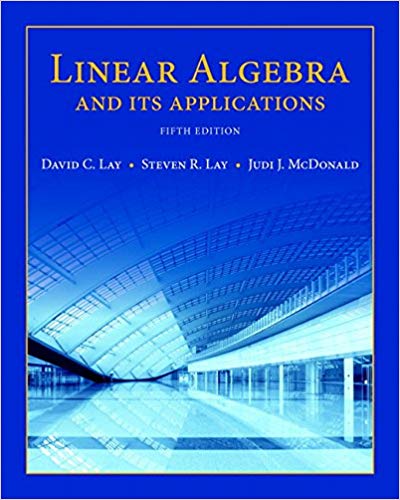
Linear Algebra and Its Applications, 5th Edition
Authors: David C. Lay, Steven R. Lay, Judi J. McDonald
ISBN-13: 978-0321982384
We have solutions for your book!
See our solution for Question 41E from Chapter 3.1 from Lay's Linear Algebra and Its Applications, 5th Edition.
Problem 41E
Chapter:
Problem:
Step-by-Step Solution
Given Information
We are given with vectors: \[ \mathbf { u } = \left[ \begin{array} { l } { 3 } \\ { 0 } \end{array} \right] \text { and } \mathbf { v } = \left[ \begin{array} { l } { 1 } \\ { 2 } \end{array} \right] \] We have to compute the area of the parallelogram determined by u, v, u+v and 0 and compute the determinant of [u v].
Step-1: The Area
The base of the parallelogram has length 3 and the height of the parallelogram is 2.
\[ \begin{array} { l } { \text { Area } = \text { base } \times \text { height } } \\ { A = 3 \times 2 } \\ { \quad = 6 } \end{array} \]
Step-2: The Matrix [u v]
\[ \left[ \begin{array} { l l } { \mathbf { u } } & { \mathbf { v } } \end{array} \right] = \left[ \begin{array} { l l } { 3 } & { 1 } \\ { 0 } & { 2 } \end{array} \right] \] The determinant of matrix: \[ \begin{aligned} \| \mathbf { u } \quad \mathbf { v } \| & = \left| \begin{array} { l l } { 3 } & { 1 } \\ { 0 } & { 2 } \end{array} \right| \\ & = 6 - 0 \\ & = 6 \end{aligned} \]
The Area of the parallelogram is equal to determinant of [u v]
Step-3: The new Matrices
\[ \mathbf { u } = \left[ \begin{array} { l } { 3 } \\ { 0 } \end{array} \right] , \mathbf { v } = \left[ \begin{array} { l } { x } \\ { 2 } \end{array} \right] \] Area of the new parallelogram: \[ \begin{aligned} \operatorname { det } [ \mathbf { u } \quad \mathbf { v } ] & = \left| \begin{array} { c c } { 3 } & { x } \\ { 0 } & { 2 } \end{array} \right| \\ & = 6 - 0 \\ & = 6 \end{aligned} \] Therefore,
The parallelogram is unchanged and the altitude remains 2 in both cases
We are given with vectors: \[ \mathbf { u } = \left[ \begin{array} { l } { 3 } \\ { 0 } \end{array} \right] \text { and } \mathbf { v } = \left[ \begin{array} { l } { 1 } \\ { 2 } \end{array} \right] \] We have to compute the area of the parallelogram determined by u, v, u+v and 0 and compute the determinant of [u v].
Step-1: The Area
The base of the parallelogram has length 3 and the height of the parallelogram is 2.
\[ \begin{array} { l } { \text { Area } = \text { base } \times \text { height } } \\ { A = 3 \times 2 } \\ { \quad = 6 } \end{array} \]
Step-2: The Matrix [u v]
\[ \left[ \begin{array} { l l } { \mathbf { u } } & { \mathbf { v } } \end{array} \right] = \left[ \begin{array} { l l } { 3 } & { 1 } \\ { 0 } & { 2 } \end{array} \right] \] The determinant of matrix: \[ \begin{aligned} \| \mathbf { u } \quad \mathbf { v } \| & = \left| \begin{array} { l l } { 3 } & { 1 } \\ { 0 } & { 2 } \end{array} \right| \\ & = 6 - 0 \\ & = 6 \end{aligned} \]
The Area of the parallelogram is equal to determinant of [u v]
Step-3: The new Matrices
\[ \mathbf { u } = \left[ \begin{array} { l } { 3 } \\ { 0 } \end{array} \right] , \mathbf { v } = \left[ \begin{array} { l } { x } \\ { 2 } \end{array} \right] \] Area of the new parallelogram: \[ \begin{aligned} \operatorname { det } [ \mathbf { u } \quad \mathbf { v } ] & = \left| \begin{array} { c c } { 3 } & { x } \\ { 0 } & { 2 } \end{array} \right| \\ & = 6 - 0 \\ & = 6 \end{aligned} \] Therefore,
The parallelogram is unchanged and the altitude remains 2 in both cases